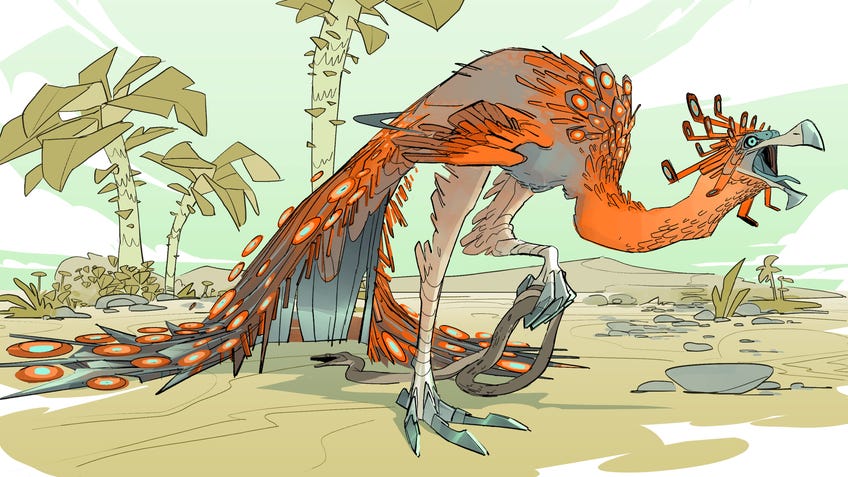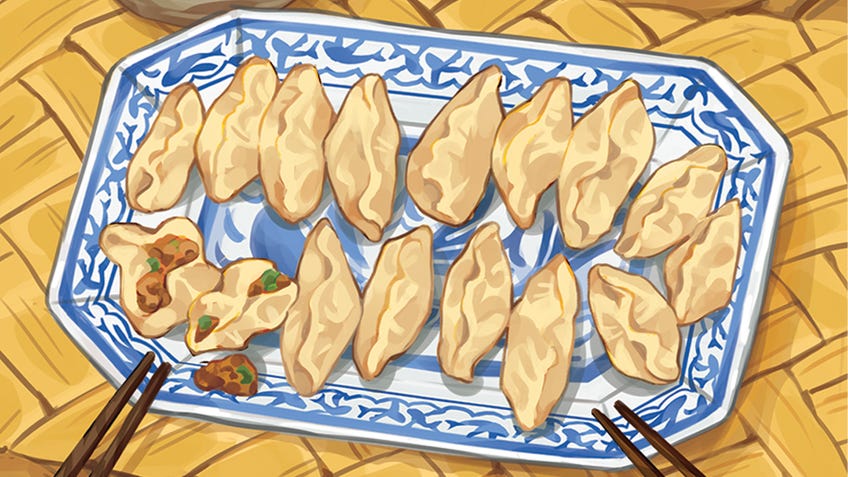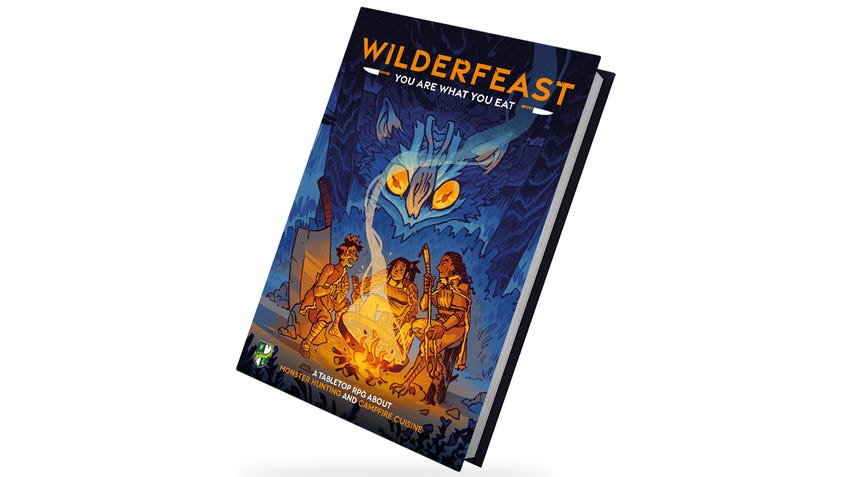Monster Hunter-inspired RPG Wilderfeast is a delectable celebration of food and living in harmony with nature - exclusive preview
An exclusive first look at KC Shi’s upcoming game of cooking, combat and eco-awareness as its quickstart rules release.
Food is more than sustenance. Food is culture, community, personality, self-expression. Whether you eat meat or not. How spicy you prefer your meals. Whether to add sauce, and what sauce? The order in which you approach eating - start with the highlight, end with the best lingering taste or have a bit of everything all at once? Texture, flavour, presentation, smell. The history of a dish, and the sacrifice, work and care taken to create it.
Upcoming RPG Wilderfeast, and its designer KC Shi, clearly understand food. Most importantly, they understand that food is more than basic survival. This is a game where you hunt gigantic monsters and turn them into meals. But not just meals. Feasts. And not just feasts, but feasts that allow you to carry the power of that monster forward.
From this concept comes the game’s quite literal approach to the adage “you are what you eat”. Eating a bat-like monster might grant you the power of flight, while chowing down on a fish might allow you to breathe underwater. It’s a key part of Wilderfeast, as the players’ wilders gain the power to become human-creature hybrids blessed with the abilities of the animals they consume.
Such a concept could quickly run amok in the wrong hands, with players encouraged to slaughter their way through a fantastical animal kingdom in pursuit of all manner of powers. Wilderfeast carefully balances its clear love of cuisine and its preparation with a central message about respecting where our food comes from, and working to maintain balance between humanity’s needs and nature’s protection.
Ahead of the public release of Wilderfeast’s quickstart - which includes the game’s basic rules, a mini-bestiary containing four of its creatures and a complete introductory adventure - and its planned Kickstarter later this year, Dicebreaker was able to get an exclusive first look at this intriguing and thoughtful culinary RPG.

Wilderfeast takes place in the One Land, a setting inhabited by creatures that resemble fantastical takes on real-world animals from bats and monkeys to squid and peacocks. The world mixes together post-apocalyptic and futuristic technology, with primitive melee weapons replacing guns as floating trains zoom overhead. Shi’s vision of the One Land draws from the real world in both its geography and food, with the core rulebook’s region of the Sen Coast melding the climate of southern California with the cultural influence of four regional Chinese cuisines.
Wilderfeast carefully balances its clear love of cuisine with a central message about respecting where our food comes from, and working to maintain balance between humanity’s needs and nature’s protection
The setting’s kaiju-like animals serve as the drive of players’ adventures across the One Land, as their wilders head out in search of animals afflicted by ‘frenzy’, a mysterious and deadly virus spread by the human actions of a global trading conglomerate known as the Charter. Creatures beyond recovery and for whom euthanasia is the only remaining option are their targets - an important distinction in the players’ reason for hunting them down, in order to protect the remaining fauna rather than simply for pleasure or gain.
While the idea that a group of superpowered adventurers wielding oversized kitchen utensils as their weapons against frenzied creatures is the only humane option left might raise some eyebrows, this attempt at a more conscious philosophy marks out Wilderfeast as notably different in tone to key inspirations like video game Monster Hunter and other tabletop RPGs where players hunt, kill and harvest largely for their own personal gain. (Or cooler-looking armour.)

In the same way, cooking monsters you dispatch doesn’t just serve as an indulgence; it’s framed as the world’s way of purifying defeated creatures to avoid the frenzy spreading. Wilderfeast cements this respectful acknowledgement of where food comes from - and its literal life cost - by encouraging the player characters to give thanks before each meal. Those meals then grant players’ wilders new skills by taking on a monster’s unique effects and abilities, literally embodying the natural traits of the monsters they consumer.
This thoughtful, grounded approach to an otherwise fairly outlandish premise - tackling huge monsters with massive weapons to absorb their powers - gives Wilderfeast its heartfelt core as an RPG with key messages about eco-conservation, harmony with nature and appreciating humanity’s use of animals.
Players’ interaction with animals isn’t limited to cutting them down before cutting them up; those creatures unafflicted by frenzy must be fed, healed and cared for in order to help maintain the natural world. In addition, players are accompanied by a monster companion - an acquaintance akin to Avatar: The Last Airbender’s Appa or even just Geralt’s horse Roach in The Witcher - who more directly symbolises their connection to the natural world.
Needing to uphold the balance between humanity and nature is a crucial part of Shi’s gameplay design, codified as harmony - a measure of the party’s relationship with the natural world and its inhabitants. Harmony acts as a finite resource shared between the group of wilders, gained as they eat meals - continuing the circle of life - and potentially lost as they draw on the wild powers gained from consuming creatures, representing the discordance between their human and animal natures.
Fans of Monster Hunter and other human-versus-beast action spectacles still look to be satisfied alongside the more thoughtful moments of Wilderfeast’s design.
Still, fans of Monster Hunter and other human-versus-beast action spectacles still look to be satisfied alongside the more thoughtful moments of Wilderfeast’s design. Scenarios in Wilderfeast operate much like missions in the cooperative monster-slaying video game, as the party of wilders track a creature through the wilderness by following its tracks. This tracking spans multiple areas (the number depends on the environment and distance to your target) that provide the group with chances to prepare for their big encounter by foraging for ingredients or camping to recover from conditions, before moving on - rolling to overcome the area’s hazards and terrain.
Once you do encounter a creature, combat abstracts the wilders’ distance from the gigantic beast, abstracting their distance into ‘strides’ that affect weapons’ effective range. It gives combat the fast, fluid feel of constantly strafing around a massive creature to dodge attacks and find opportunities to attack, without requiring you to break out rulers and keep track of feet and inches.

Combat turns are similarly simplified, with each player getting three actions. The monster takes its turns between each player, with the controlling GM able to choose whether it performs a single action or - once per round - a full turn of three actions. Actions can include going in for a swing or shot - which could be swift but lighter, or stronger but slower, depending on the style chosen - bracing to defend against an incoming attack, taunting the monster to draw its attention, and more.
In another Monster Hunter-like detail, players can target specific parts of a monster, whether their shell or claws, to reduce their durability and create openings during battles. Players’ tools also have durability, though, and can eventually break, leaving them vulnerable. Destroying specific parts can change the monsters’ available abilities and effects - reducing its range, impeding its movement or something else - making battles dynamic with the feel of a multi-phase video game boss fight.

Once a monster is felled, the players can prepare it for their post-hunt feast. As well as allowing for experimentation in the recipes you create - using both the creature and any ingredients you’ve foraged - feasts present the chance to gain knowledge of both the monster and yourself, as players offer up details on how the dish relates to their past and what they will remember in the future. Once prepared, thanks are given and the food is eaten, players can gain levels in one of the creature’s traits, enabling them to make use of its powers in future adventures.
Like the meals its wilders cook up after each battle, Wilderfeast’s dice rolls aim to construct a flavourful, filling experience out of fairly simple ingredients.
Like the meals its wilders cook up after each battle, Wilderfeast’s dice rolls aim to construct a flavourful, filling experience out of fairly simple ingredients. Tests are typically broken down into two key aspects: the style in which the player is approaching the action, and the skill they are using to perform it. There are just four styles used to cover a broad range of - swift, mighty, precise and tricky - with skills being more multitudinous and serving as more granular abilities. Things like crafting, searching, displaying, grabbing or offering assurance.
Your choice of style determines how many six-sided dice you roll, with your level in a skill then adding to the outcome - up to three extra points across all your dice. This pool combines with a single d8, which activates when at least one success - a five or six - is rolled on your style dice. The d8 judges the overall quality of your success, from a partial up to a critical.

There’s the option to call upon your wild side - enabled by the ability-absorbing meals you eat - for a riskier but potentially more beneficial outcome. Going wild swaps the d8 for D&D’s favourite die, the d20, upping the likely quality of your success. But it comes at the cost of one of your style dice - reflecting the loss of control as you give in to your animal nature - increasing the chance of no successes and a complete failure.
The original gameplay system and wild element is an engaging way of mechanising Wilderfeast’s central push-and-pull between utilising nature without harming or exploiting it. From the quickstart rules, the system is light but flexible, providing plenty of space for players to adapt it to their characters’ ambitions without weighing down the game with unnecessarily complexity or endless dice rolls.

From my time so far, Wilderfeast cooks up a delectable mixture of light gameplay with the rich depth of a roleplaying game striving to make sessions about more than just defeating monsters and eating heartily. Its thoughtful, considered approach to depicting food, culture and nature as interconnected joins with the exciting clashes of human against beast, finding its own harmony between a heartfelt indie RPG and an approachable game with roots in popular video games and genres.
The quickstart rules are the ideal morsel to whet your appetite for the game’s full release following its Kickstarter on September 5th - just be wary that you may well be left hungry for more.


